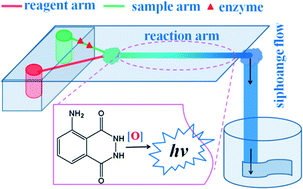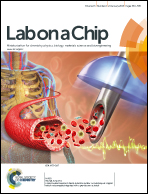A siphonage flow and thread-based low-cost platform enables quantitative and sensitive assays†
Abstract
For pump-free, material abundant, portable, and easy-to-operate low-cost microfluidics, a siphonage flow microfluidic thread-based analytical device (S-μTAD) platform enabling quantitative and sensitive assays was designed. Renewable and continuous siphonage flow allowed replicate sampling and detection on one channel/device, obviating some possible inconsistencies among channels or devices. Y-shaped channels were fabricated with polyester cotton blend thread, due to its greater chemiluminescent sensitivity in comparison with that of cotton and polyester threads. S-μTAD sensors for glucose and uric acid were fabricated by using oxidase-immobilized cotton thread as the sample arm of the channels. The acceptable reproducibility and high sensitivity, demonstrated by the relative standard deviations of less than 5% in all cases and the detection limits of 4 × 10−8 mol L−1 for hydrogen peroxide, 1 × 10−7 mol L−1 for glucose, and 3 × 10−6 mol L−1 for uric acid, demonstrated the feasibility of the S-μTAD for quantitative assays. Good agreements between S-μTAD/sensor results and hospital results for blood glucose and uric acid assays indicated the capability of S-μTAD/sensors for the analysis of real samples. These findings proved the utility of siphonage for low-cost microfluidics and the suitability of our S-μTAD design for quantitative assays.


 Please wait while we load your content...
Please wait while we load your content...